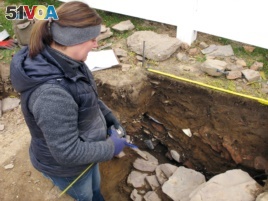21 November, 2018
People from two towns in the eastern state of Connecticut are arguing again about which is the oldest continuously inhabited town in the state.
Connecticut, which was one of the British colonies, has a long history.
The trouble started when experts discovered artifacts in the town of Wethersfield that are believed to date to the 1630s. The town says it was established in 1634.
But a few miles up the Connecticut River is Windsor, which claims it was settled in 1633.
The dispute has gone on for many years with both towns claiming to be the oldest.
There is even a dispute over the definition of a town.
Town or no town
Settlers from Plymouth, Massachusetts established a trading post in Windsor in the year 1633.
Opponents say settlers from Watertown, Massachusetts made Wethersfield their home in 1634. They say people in Windsor did not build homes until the following year.
Brian Jones is an archaeologist for the state. He said, "I don't think it will ever be settled."
Jones noted that the Dutch built a fort in Hartford in 1633 before the Windsor trading post and there is some evidence of a trading post there from 10 years earlier.
Recent evidence might throw some light on the dispute.
Archaeologists working in Wethersfield say they have physical evidence of a settlement by people with European ancestors.
They found a fence from the 17th century believed to have been used as a defense against Native Americans. They also found metal money and ceramics, beads used for trade and other objects including shells and animal bones.

In this Thursday, Nov. 15, 2018, photo archaeologist Sarah Sportman works at a dig site in Wethersfield, Conn.
Sarah Sportman is an archeologist with the group Public Archeology Survey Team. She said, "The 17th-century stuff was the most exciting because nobody knew it would be here."
Some of the objects appear to date back to the 1630s.
The non-profit group will save the objects for the public and write a report on them. The study began two years ago and ended in November.
The discovery was made when work started on a visitor center for the Webb-Deane-Stevens Museum in the town. The museum includes the home of Joseph Webb. In 1781, George Washington and French General Compte Jean de Rochambeau met there to discuss battle plans during the Revolutionary War. The house of Silas Deane is also part of the museum. He served as a delegate to the First Continental Congress in 1774 and as a diplomat to France. Deane worked with Benjamin Franklin.
The archeological study was required by the state government to preserve any important artifacts found.
That however does not change the mind of Windsor's supporters.
Christine Ermanc is the executive director of the Windsor Historical society. "We maintain that Windsor really is the earliest European settlement. They helped the Native Americans. They helped some of the traders going to Wethersfield," she said.
I'm Mario Ritter Jr.
The Associated Press reported this story. Mario Ritter Jr. adapted it for VOA Learning English. Caty Weaver was the editor.
We want to hear from you. Write to us in the Comments section, and visit 51VOA.COM.
_________________________________________________________________
Words in This Story
inhabit - v. to live in (a place) : to have a home in (a place)
artifact –n. a simple object, such as a tool or weapon, that was made by people in the past
maintain –v. to keep in good condition by making repairs and correcting problems.